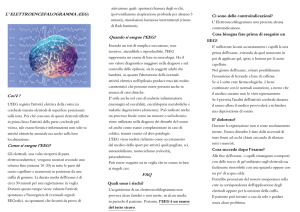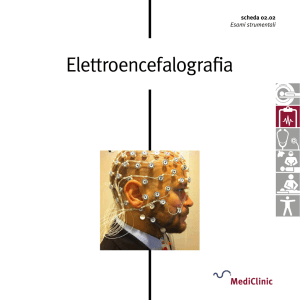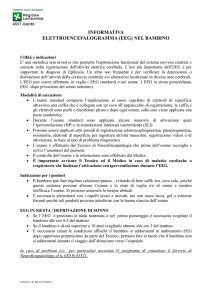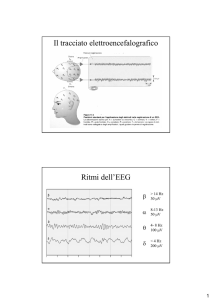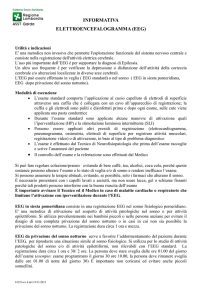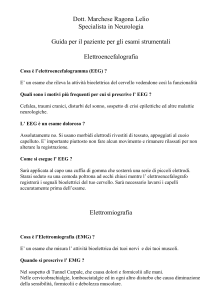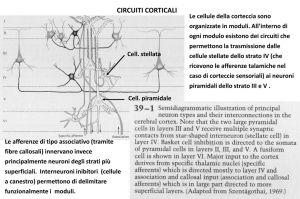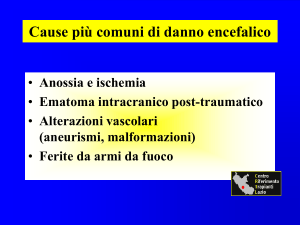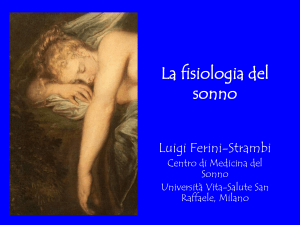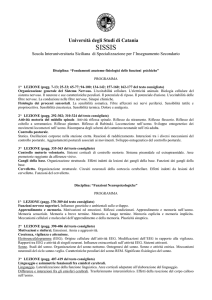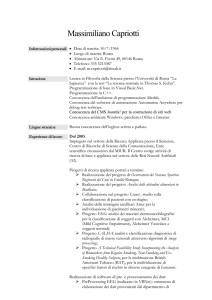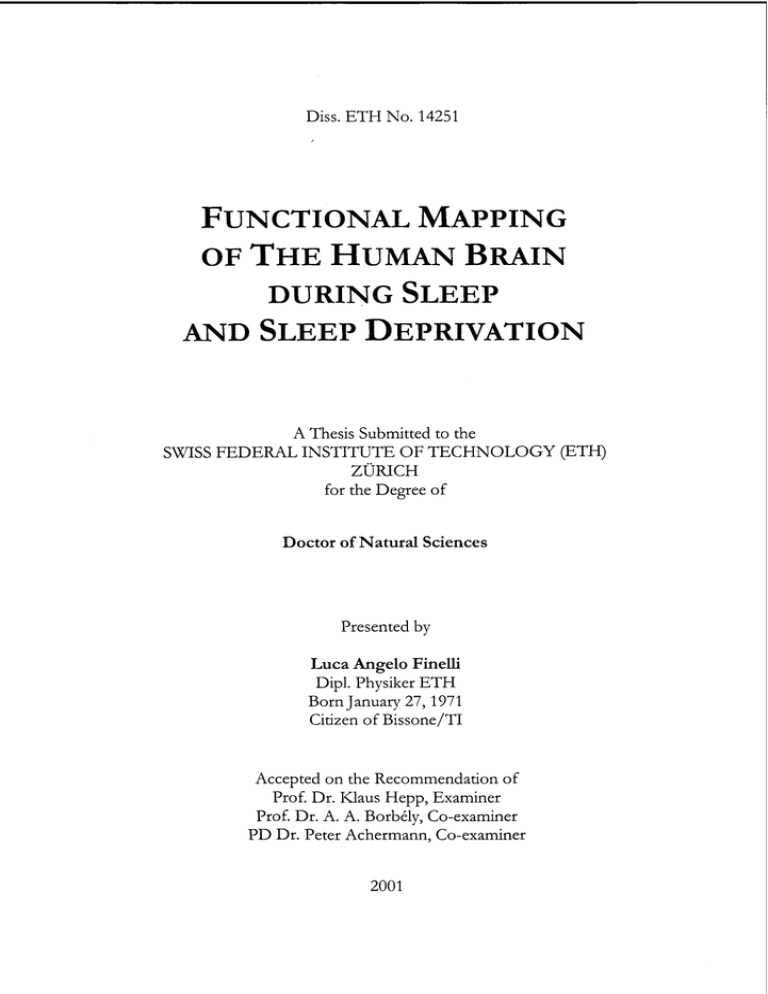
Diss. ETH No. 14251
FUNCTIONAL MAPPING
OF THE HUMAN BRAIN
DURING SLEEP
AND SLEEP DEPRIVATION
A Thesis Submitted to the
SWISS FEDERAL INSTITUTE OF TECHNOLOGY (ETH)
ZÜRICH
for the Degree of
Doctor of Natural Seiences
Presented by
Luca Angele Finelli
Dipl. Physiker ETH
Born January 27,1971
Citizen of Bissone/TI
Accepted on the Recommendation of
Prof. Dr. Klaus Hepp, Examiner
Prof. Dr. A. A. Borbely, Co-examiner
PD Dr. Peter Achermann, Co-examiner
2001
SUMMARY
Sleep is a regulated behavior characterized by distinctive patterns of neural
activity. The anatomieal and functional design of the brain is highly structured
and differentiated, strongly suggesting that sleep may have brain-region specific
(local) aspects. This hypothesis is supported by experimental evidence acquired
in several species, including humans. The aim of the studies composing this
thesis was to gain further insight into the nature of regional differences
characterizing human brain activity during sleep.
The thesis divides into four parts: part 1, a general introduction; part 2,
devoted to the study of sleep and prolonged waking with multi-channel electroencephalogram (EEG); part 3, concerning the conjoint use of positron
emission tomography (pE1) and EEG in the study of sleep, and part 4,
concluding remarks.
Chapter 2.1 provides an overview of the use of EEG in the study of
behavioral states. The data presented in Chapters 2.2 and 2.3 arose from an
experiment in which multi-channel EEG (27 derivations) was recorded in eight
healthy young males during a baseline night, intermittently during a 40-h waking
episode, and finaily during recovery sleep. The objective of the study presented
in Chapter 2.2 was to investigate in the same individual the relationship
between markers of sleep homeostasis in waking and sleep. A positive
correlation was demonstrated between the rise rate of theta activity (power in
the 5-8 Hz range; C3A2 derivation) during extended waking and the increase of
slow-wave activity (power in the 0.75-4.5 Hz range) in the first non-rapid eye
movement (nonREM) sleep episode of the recovery night, as compared to
baseline. The topographie analysis showed that both effects were largest in
frontal areas.
In Chapter 2.3 the topographie analysis of nonREM sleep was further
developed by ca1culating mean power maps for 1-Hz bins between 1.0 and
24.75 Hz in baseline and recovery. A cluster analysis disclosed a segregation of
the maps that defined distinct frequency bands. The topographicaily classified
bands (similar for baseline and recovery sleep) corresponded very weil to the
traditional frequency bands. Features of the maps were the frontal
predominance in the delta and alpha band, the occipital predominance in the
theta band, and a sharply delineated vertex maximum in the sigma band. The
Vll
increase in power in the low-frequency range (1-10.75 Hz) associated with sleep
loss was largest over the frontal region, while the decrease in power in the
sigma band (13-15.75 Hz) was most evident over the vertex. The topographic
pattern of the recovery/baseline power ratio was similar to the power ratio
between the first and second half of the baseline night. It was concluded that
the different EEG oscillations are characterized by their signature in the
frequency domain and by their typical spatial distribution. Changes in sleep
propensity are reflected by specific regional differences in EEG power. The
increase of low-frequency power predominant in frontal areas may be due to a
high 'recovery need' of the frontal, heteromodal association areas of the cortex.
The question of whether the regional changes in the EEG may be a sign of
different levels of cortical activation was addressed. This hypothesis was tested
in a joint PET/EEG study, combined with the investigation of the effects of
the hypnotic zolpidem (Chapters 3.2 and 3.3). Eight healthy subjects were
sleep-deprived to promote sleep in the scanner. During sleep regional cerebral
blood flow (rCBF) was lower after zolpidem than after placebo in the basal
ganglia and insula, and higher in the parietal cortex. Zolpidem also attenuated
EEG power in the entire 1.75-11.0 Hz range. Specially in REM sleep, zolpidem
induced lower rCBF in the anterior cingulum as compared to placebo, whereas
rCBF in occipital and parietal cortex, parahippocampal gyrus and cerebellum
was higher. Comparison of the pooled data (drug and placebo) of stage 2 and
stage 4 to wakefulness showed lower rCBF values in prefrontal cortex and
insula, and higher values in occipital and parietal cortex. Compared to a baseline
night, sleep deprivation increased EEG power (1.25-7.0 Hz range) in nonREM
sleep in the placebo night. After zolpidem, power in the 3.75-10.0 Hz range and
in the 14.25-16.0 Hz bin was reduced, with the largest decrease in the theta
band. For nonREM sleep a drug-induced posterior shift of power in the
frequency range of 7.75-9.75 Hz was observed. We concluded that some
differences in rCBF from wakefulness to nonREM sleep are further augmented
by zolpidem. Also, sleep deprivation and agonistic modulation of GABAA
receptors have separate and additive effects on power spectra and their effects
are mediated by different neural mechanisms.
The work presented here provides strong evidence that specific regions and
systems of the brain may be involved in, or highly responsive to, the process of
homeostatic sleep regulation. The observed signs of locally increased sleep
intensity could reflect a more intense, use-dependent recovery process.
Vlll
RIASSUNTO
Il sonno e un eomportamento regolato, definito da sehemi speeifiei di attivita
neurale. L'arehitettura anatomiea e funzionale del eervello, altamente strutturata
e differenziata, suggerisee ehe il sonno possa avere manifetsazioni loeali,
specifiehe a determinate regioni del eervello. Questa ipotesi e eonfermata da
evidenze sperimentali aequisite in diverse specie animali, inclusi gli esseri umani.
L'obiettivo degli studi presentati in questa tesi e stato di aequisire maggiori
informazioni sulla natura delle differenze regionali ehe si osservano nell'attivita
del eervello negli esseri umani durante il sonno.
La tesi si divide in quattro parti: parte 1, introduzione generale; parte 2,
studio del sonno edella veglia prolungata eon elettroeneefalogramma a eanali
multipli (BEG); parte 3, uso eongiunto del tomografia ad emissione di
positroni (pE1) e del EEG nello studio del sonno; parte 4, eonsiderazioni
eonclusive.
Nel Capitolo 2.1. viene deseritto in ehe modo l' EEG pUD essere utilizzato
per analizzare stati eomportamentali. I dati presentati nei Capitoli 2.2 e 2.3 sono
il risultato di un esperimento eondotto su otto giovani ragazzi in buona salute,
durante il quale e stato registrato l'EEG a eanali multipli (27 eanali). Le
registrazioni sono state effettuate durante una notte di riferimento (baseline),
sueeessivamente ad intermittenza in un periodo di 40 ore di veglia estesa, ed
infine durante la notte di sonno di reeupero. L'obiettivo dello studio presentato
nel Capitolo 2.2 e stato di determinare, nel medesimo individuo, l'esistenza di
una eorrelazione tra mareatori omeostatiei sonno-specifici nella veglia e nel
sonno. Tale analisi ha permesso di dimostrare l'esistenza di una eorrelazione
positiva tra la velocita di ineremento dell'attivita EEG theta (nella banda 5-8
Hz; derivazione C3A2) nel periodo di veglia prolungata e l' aumento dell'attivita
EEG delle onde lente (0.75-4.5 Hz) nella prima fase di sonno senza movimenti
oeulari rapidi (nonRE11) della notte di reeupero, rispetto alla notte baseline.
L'analisi topografiea ha dimostrato ehe entrambi gli effetti sono
prevalentemente evidenti nell'area frontale del eervello.
Nel Capitolo 2.3, l'analisi topografiea del sonno nonREM e stata
approfondita ulteriormente. Sono state ealcolate mappe medie di attivita EEG
per intervalli eonseeutivi di 1 Hz tra 1.0 e 24.75 Hz, durante la notte di
riferimento e la notte di reeupero. Una 'cluster analysis' ha evidenziato
IX
l'esistenza di una segregazione delle mappe di attivita, definendo bande di
frequenza ben distinte. Le bande di frequenza classificate topograficamente
(molto simili tra la notte baseline la notte di recupero) corrispondono in modo
straordinario alle bande di frequenza classiche. Le mappe sono caratterizzate
dalla predominante localizzazione di attivita nella parte frontale nelle bande
delta ed alfa, nella zona occipitale nella banda theta, e dalla netta delineazione di
un massimo al 'vertex' nella banda sigma. L'aumento dell'attivita EEG a bassa
frequenza (1-10.75 Hz) associato alla perdita di sonne e risultato preponderante
nella regione frontale, mentre la riduzione di attivita nella banda sigma
(13-15.75 Hz) si e mostrata piu evidente al 'vertex'.
La distribuzione
topografica del rapporto di attivita EEG 'sonno ricostitutente'/'notte di
riferimento' era simile a quelle del rapporto tra prima e seconda parte della
notte di riferimento. Si e giunti alla conclusione ehe le diverse oscillazioni del
EEG sono caratterizzate non solo dalla loro impronta nello spazio delle
frequenze, ma anche dalla loro tipica distribuzione spaziale. Inoltre, livelli
differenti di propensione al sonne sono accompagnati da diversita regionali
specifiche dell'attivita EEG. L'aumento dell'attivita EEG a bassa frequenza
predominante in aree frontali potrebbe essere dovuto ad un grande 'bisogno di
recupero' delle aree associative eteromodali frontali della corteccia cerebrale.
Si e voluto appurare se variazioni regionali nell'elettroencefalogramma
possano essere un indice di livelli diversi di attivazione nella corteccia cerebrale.
Questa ipotesi e stata investigata usando PET ed EEG contemporaneamente,
unitamente all'indagine sugli effetti dell'ipnotico zolpidem (Capitoli 3.2 e 3.3).
Otto soggetti sani sono stati sottoposti a veglia prolungata al fine di favorirne il
sonne nel tomografo. Per effetto di zolpidem si e osservato (rispetto ad un
placebo) un flusso sanguigno cerebrale regionale (FSCr) minore nei gangli basali
e nell'insula, e maggiore nella corteccia parietale. Lo zolpidem ha anche
attenuato l'attivita EEG nella intera banda tra 1.75 e 11.0 Hz. In particolare nel
sonne REM, la somministrazione di zolpidem, rispetto a quella di placebo, ha
indotto un FSCr minore nella corteccia cingolata anteriore. Contrariamente il
FSCr si e rivelato maggiore nella corteccia occipitale e parietale, nel giro
paraippocampale e nel cervelletto. Il confronto dei dati combinati (farmaco e
placebo) degli stadi 2 e 4 con quelli della veglia ha indicato valori minori di
FSCr nella corteccia prefrontale e nell'insula, mentre valori maggiori si sono
osservati nelle cortecce occipitale e parietale. Rispetto ad una notte di
riferimento, la veglia prolungata ha aumentato l'attivita EEG (banda 1.25-7.0
Hz) durante il sonne nonREM nella notte dopo somministrazione di placebo.
x
Dopo somministrazione di zolpidem, l'attivita nelle bande 3.75-10.0 Hz e
14.25-16.0 Hz e risultata diminuita, influendo maggiormente sulla banda theta.
Nel sonno nonREM il farmaeo ha anehe indotto uno spostamento dell'attivita
EEG nella banda di frequenza 7.75-9.75 Hz verso aree eerebrali posteriori.
Siamo giunti alla eonclusione ehe alcune differenze in FSCr tra veglia e sonno
nonREM sono ulteriormente aumentate in easo di somministrazione di
zolpidem. Inoltre, la deprivazione del sonno e la modulazione agonistiea dei
reeettori GABA A hanno effetti diversi ed addittivi sull'attivita spettrale
dell'EEG. Questi effetti sono mediati da meeeanismi neurali differenti.
I risultati presentati in questa tesi mostrano ehiaramente ehe differenti aree e
eentri eerebrali possono essere 0 eoinvolti in modo specifieo, od essere
estremamente sensibili al proeesso di regolazione omeostatiea del sonno. Gli
indizi osservati di una maggiore intensita di sonno in determinate parti del
eervello potrebbero indieare ehe le stesse siano sottoposte ad un proeesso di
reeupero piu intenso, dipendente dall'uso.
Xl

